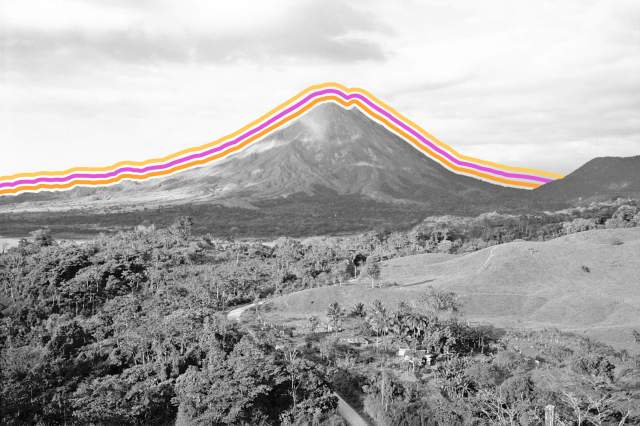
There Are Three Main Types of Volcanoes
“Cinder cone” aptly describes how this simple volcano forms: As lava bursts out of the earth, it cools and falls back to the surface as pebbly textured cinder, piling up around the original site of the eruption. The cinder eventually forms a dark, smooth-sided cone.
Stratovolcanoes, or composite volcanoes, are made of multiple layers of volcanic rock and ash, often several thousand feet high. These mountainous volcanoes often result in huge eruptions of thick lava and tephra (small rocky fragments) that build up over time. About 60% of the world’s volcanoes are stratovolcanoes, and they include Mount St. Helens, Mount Etna, Eyjafjallajökull, Cotopaxi, Mount Pinatubo, and many more.
Shield volcanoes lack dramatic height but can still be potent. Lava erupts or oozes from multiple spots and spreads out over land; constant eruptions and lava flows eventually form low, wide domes. The Hawaiian Islands are a chain of shield volcanoes that includes Kīlauea, one of the world’s most active eruptors.

Eruptions Are Measured by the Volcanic Explosivity Index
The power of a volcanic eruption is measured on a scale from 0 to 8, called the Volcanic Explosivity Index, according to the amount of lava, tephra, and ash that spews forth. An eruption with a VEI of 0 is basically dormant; each subsequent number indicates a tenfold increase in ejected material. The 1980 eruption of Mount St. Helens was a VEI 5, Krakatau in 1883 was a VEI 6, and Tambora’s explosion in 1815 was a VEI 7. The most recent “megacolossal” eruption took place in 2022 at Hunga Tonga Ha’apai: The blast destroyed 90% of the South Pacific island and merited a VEI of 6.

The “Ring of Fire” Is Earth’s Most Active Volcano Zone
Volcanoes exist on all seven continents. But about 75% of the world’s 1,500 active volcanoes are located in the “Ring of Fire,” a chain of volcanic mountains and islands around the edges of the Pacific Ocean. The volcanoes are clustered near subduction zones — unstable areas where one of Earth’s heavy tectonic plates slides under a lighter one. The movements trigger earthquakes, as well as a buildup of magma (molten rock) where the plates scrape together. Magma often escapes through the lighter plate as a volcano.
More Interesting Reads

The U.S. Has a Surprisingly High Number of Volcanoes
Three volcanoes in the Lower 48 have erupted since the Declaration of Independence was signed: Mount St. Helens in Washington, Mount Hood in Oregon, and Lassen Peak in California. But due to the statehoods of Alaska and Hawaii in 1959, the U.S. now ranks first in the world in the number of potentially active volcanoes per nation, with 162. They include the planet’s largest active volcano, Hawaii’s Mauna Loa, which rises 2.5 miles above sea level and 10.5 miles above its base on the bottom of the ocean. Alaska’s Novarupta volcano, in present-day Katmai National Park and Preserve, had the biggest eruption of the 20th century, beginning on June 6, 1912 (it earned a VEI of 6).

Volcanoes Can Change Earth’s Climate
The biggest eruptions can shoot tons of ash and gas high into the atmosphere, where they can block some of the sun’s radiation and be dispersed around the world by air currents. These aerosols can actually change Earth’s climate for a few years. The 1815 eruption of Mount Tambora in Indonesia caused “the year without a summer” in Europe and New England in 1816; colder-than-average temps and heavy rains caused crops to fail. Sulfuric acid in the atmosphere following the Novarupta blast blackened brass and caused fabrics to disintegrate in Vancouver, British Columbia, and Port Townsend, Washington. Mount Pinatubo’s eruption in 1991 sent ash into the stratosphere and cooled the globe for about two years. Some scientists predict that water vapor ejected into the atmosphere from the Hunga Tonga Ha’apai eruption in 2022 may temporarily intensify global warming.

A Volcano Made the Loudest Sound Ever Recorded
When Krakatau blew its top in August 1883, it released a boom that geologists believe was the loudest sound in recorded history. The 310-decibel cataclysm was heard over 2,000 miles away in Australia, where ranchers thought it was a rifle shot; people 3,000 miles away thought it was a cannon blast from a nearby ship. In addition to the eardrum-busting noise, the volcano released 6 cubic miles of material into the atmosphere, triggered tsunamis that killed 36,000 people, and coated the sea in layers of floating pumice.











